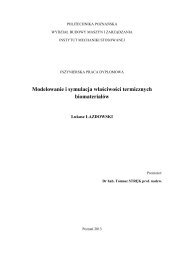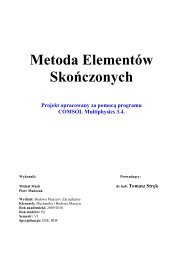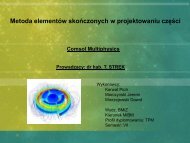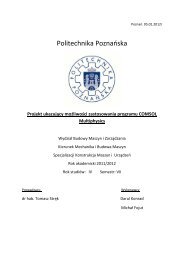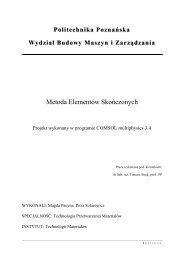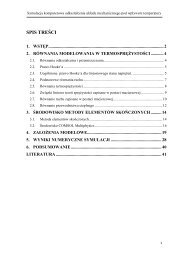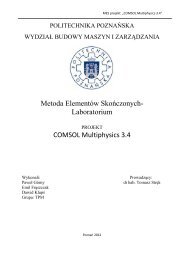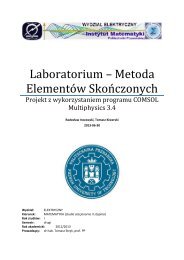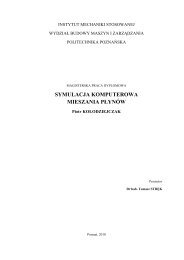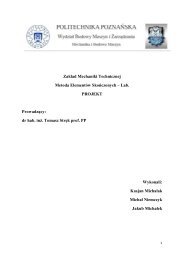Lithium-Ion Battery Simulation for Greener Ford Vehicles
Lithium-Ion Battery Simulation for Greener Ford Vehicles
Lithium-Ion Battery Simulation for Greener Ford Vehicles
You also want an ePaper? Increase the reach of your titles
YUMPU automatically turns print PDFs into web optimized ePapers that Google loves.
MEDICAL<br />
MICROVISK TECHNOLOGIES, NORTH WALES, UK<br />
Easy and Accurate Measurement of Blood Viscosity<br />
with Breakthrough MEMS-Based Device<br />
<strong>Simulation</strong>-led design has put Microvisk on track to take advantage of the huge home healthcare market<br />
when it launches a hand held device that allows individuals to monitor their own blood viscosity quickly,<br />
easily and reliably.<br />
BY JENNIFER HAND<br />
The viscosity of blood is widely regarded<br />
as an indicator of general health.<br />
When a blood vessel is damaged or broken<br />
loss of blood needs to be minimized<br />
so a series of reactions (known as the clotting<br />
cascade) begins and a blood clot is<br />
<strong>for</strong>med. A number of medical conditions<br />
adversely affect this process and in these<br />
cases patients are often prescribed an<br />
anti-coagulant such as warfarin. Health<br />
management <strong>for</strong> many of these individuals<br />
involves the weekly monitoring of<br />
blood clotting time to ensure that drug<br />
dosage is appropriate.<br />
Existing hand held devices work by<br />
inducing a chemical reaction which is<br />
picked up by electrodes coated with compounds,<br />
a technology that has not fundamentally<br />
changed in many years. In contrast,<br />
Microvisk has developed a radical<br />
new technique that stems from futuristic<br />
research on microtechnology and harnesses<br />
the power of Micro Electronic Mechanical<br />
Systems (MEMS).<br />
Figure 1. Microvisk’s MEMS-based micro-cantilever device.<br />
A Completely Different<br />
Architecture<br />
Microvisk’s MEMS-based micro-cantilever<br />
devices are produced on a wafer-scale,<br />
where thousands of identical microchips<br />
are processed together as flat structures<br />
on the surface of silicon wafers. Only at<br />
the final stage of production are the micro-cantilevers<br />
released to deflect above<br />
the supporting surface, <strong>for</strong>ming truly 3D<br />
microstructures (Figure 1). Such highly<br />
de<strong>for</strong>mable and flexible micro-cantilevers,<br />
controlled by CMOS (Complementary<br />
metal-oxide-semiconductor) type signals,<br />
<strong>for</strong>m the heart of Microvisk’s unique fluid<br />
micro-probe utilized in determining the<br />
rheometric properties of minute (nanolitre<br />
volume) samples. When a current is<br />
passed through the structure each layer<br />
deflects in a different way (Figure 2). As<br />
one structural layer expands more, another<br />
expands less, which leads to each cantilever<br />
moving up and down in response<br />
to immersion in a gas or in a liquid such<br />
as blood. The speed of blood clotting and<br />
its rheometric changes associated with<br />
the clotting process can there<strong>for</strong>e be monitored<br />
in a one-stage process based on physics<br />
rather than chemistry.<br />
Dr. Slava Djakov, inventor and Sensor<br />
Development Director of Microvisk,<br />
explains why Microvisk’s approach is<br />
unique. “Other cantilever designs typically<br />
used in Atomic Force Microscopy (AFM)<br />
applications or in biological research <strong>for</strong><br />
probing and assessing DNA, protein and<br />
aptamer bindings with drugs or antibodies,<br />
usually utilize crystalline silicon (cSi)<br />
rigid cantilevers. Because of their rigidity,<br />
cSi and similar structures are very<br />
delicate, brittle and offer restricted movement.<br />
Although cSi cantilevers can be very<br />
sensitive, through actuation in resonant<br />
mode, the restricted mobility impedes per<strong>for</strong>mance<br />
once these micro-cantilevers or<br />
similar structures such as micro-bridges<br />
or membranes are immersed in liquids.<br />
Through the clever choice of polymer materials<br />
we enabled the free end of the cantilever<br />
to deflect a significantly long way<br />
up from its resting position, which makes<br />
it extremely efficient and accurate in its<br />
response. We can probe <strong>for</strong> certain parameters,<br />
<strong>for</strong> example the viscosity and visco-<br />
3 4 // C O M S O L N E W S 2 0 1 1<br />
➮<br />
Cov ToC + – A<br />
➭<br />
34-37 CN Microvisk 2011.indd 34 5/13/11 10:13 AM



